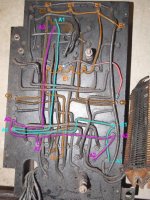Cal-
yes, the coil had zero resistance, zero continuity. the wire inside is .003" or 41 AWG. so, after 73 years, I am not suprised that it failed.
As close as I could get to counting, the coil has 68 "turns" but trying to count this without a microscope was damn hard...
each turn of the coil had a piece of .001" paper wound over it insulating the next turn. I have bought the wire, and am using Zig-Zags as the paper, and have been able to set my 10ee to .003" feed per rev, and have managed to wind a few turns correctly and with the interlaced paper. this is really difficult. I managed to get to 4 turns before the wire broke. winding 68 turns is going to be VERY difficult and I estimate a bit over 7 straight hours of winding would be required based upon the time it took me to do 4 turns...
the speed needs to be kept very low as the core of the coil is rectangular in cross section. this makes the pulling of wire onto it change speeds as it switches from short side of the rectangle and so on, with the speed changing several times per full rotation, the 1lb coil of wire had to do the same. if the speed goes up just a tiny bit too fast...snap.
winding wire the size of a human hair ~30,000 times around a 1.375" long rectangular bobbin, with 68 pieces of paper interleaved at each turn is a ***ing daunting task!
The machine is running great, it just has no AP relay, and now that I have the other 10ee running, I can tell that the DB is not working on the machine with the bad AP as well. is it possible that the DB will not work when the AP relay is bad?
I do not currently have the jumper put into the relay. it runs without it, but the DB does not work, would the jumper bring back the functionality of the DB?
I have spoken a bit (email) to 9100, and he may be able to wind the coil. I am taking a mulit faceted approach to this problem. here are the things I am working on-
1. buy a factory replacement - failed at monarch.
2. buy a factor replacement from Struthers Dunn- so far no luck, but I cannot find the relay part number on my relay. the number you provided "SD 42-314" is not currently reckognized by the SD tech guy (although he sure is trying to help) he has given me a lead to an old distributor, but I really need to find a solid part number(s) for the AP relay in question.
3. buy one used- ergo, this post.
4. wind my own- man o man, what a job...
5. Hire out the winding. very difficult job. not sure can be done economically. 9100 ballparked the price, but knowing what I know now about the coil, I am not sure that price would stand.
6. buy a whole DC box (who has one for sale?)
7. find specs for coil and or relay and source a modern replacement- thus far, cannot find specs. anyone know what they are? anyone know what DC voltage is fed into the AP relay resistor and then on to the coil?
So, you can see I am working numerous angles at this time.
Could I request that anyone out there with a DC box that looks like this, take a good close look at their AP relay and get me a part number?

The relay/coil in question is the one pictured top and middle, with the black cillinder-esque coil.







